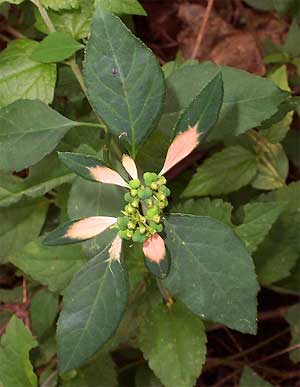Excerpts from Jim Conrad's
Naturalist Newsletter
from the October 30, 2006 Newsletter issued from Genesis Retreat in Ek Balam, Yucatán, MÉXICO
ALMOST A POINSETTIA

A common, 18-inch high herb blossoming nowadays is the "Wild Poinsettia," EUPHORBIA CYATHOPHORA. You can see a snapshot of one I took along a nearby trail at the right.
You can see in that picture that the plant merely hints at the gaudy, red-bracted item people up North buy at Christmas. In fact, the potted Poinsettias people buy are horticulturally enhanced plants derived from a different species of the same genus. They come from Euphorbia pulcherrima, a semi-woody, shrubby wild specimen of which you can see here.
Above I referred to the "red-bracted item" instead of "red-flowered item" because the Poinsettia's red parts are not parts of flowers, but rather modified leaves, or bracts. The actual flowers are tiny things with a surreal anatomy. One bizarre thing about them is that instead of producing the female part, the pistil, in the blossom's center, like a decent flower, it places it on something like a slender pole and hangs it outside the blossom. In my snapshot, the pale green, roundish things are the pistils hanging outside the flowers, the flowers being much smaller and hidden below the pistils.
So, what we have here is a genus that during its evolution into various species seems to have hit on the red-bracted theme, and it experimented with more than one species before it came up with one with really spectacular red bracts. The one in my snapshot is sort of an "early effort."